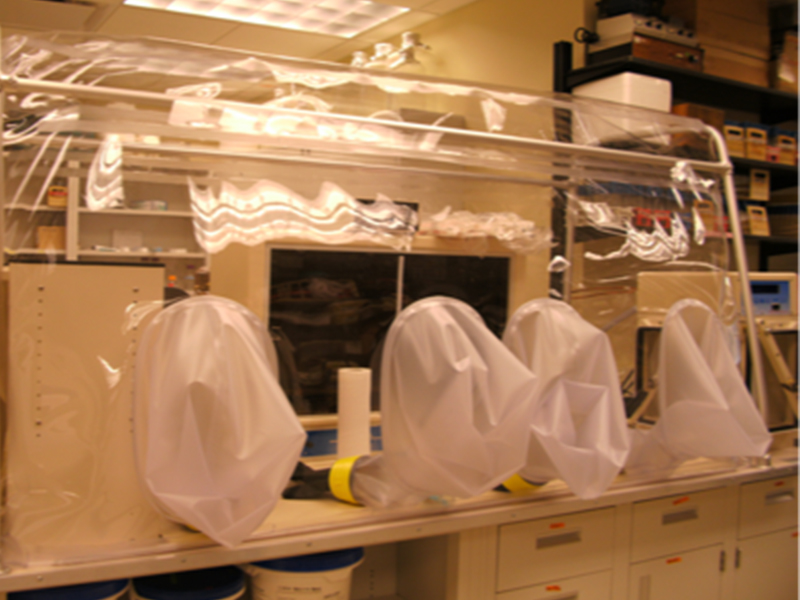Anaerobic Fungi
Isolation and characterization of novel anaerobic fungal genera
Anaerobic gut fungi (AGF) are hard to isolate and maintain. They are oxygen sensitive, prone to senescence, and have very narrow physiological optima. In addition to this, procedures for their long-term storage are often unreliable. Nevertheless, our laboratory specializes in the isolation and characterization of these fastidious critters. During the last decade, we have isolated, characterized, and named twelve novel anaerobic fungal genera (out of the twenty-two genera currently known). We have also developed clear criteria required for the characterization and rank assignment of these fungi and have been undertaking a comprehensive multi-phasic approach in establishing a clear, Linnean-based taxonomic framework for the phylum Neocallimastigomycota. Nevertheless, we still recognize the vast diversity of AGF that are yet to be brought to culture. We continue to isolate novel anaerobic fungal taxa from a wide range of herbivores, and continue to devise novel strategies, approaches, and methodological improvements for the isolation and storage of novel AGF taxa. Here is a publication from our lab on this topic.
Patterns, determinants and extent of the global anaerobic fungal mycobiome
In addition to culturing, we use multiple culture-independent strategies to assess AGF diversity in nature. We developed and continue to develop multiple phylogenetic markers for utilization in AGF diversity surveys. Our recent survey of AGF diversity involved a wide range of hosts from different countries and lifestyles to document patterns of occurrence, numbers, diversity, and community structure of AGF on a global scale. Our extensive surveys allowed us to test hypotheses regarding host-fungal evolutionary relationships (phylosymbiosis), as well as the role of diet, biogeography, and domestication status in shaping AGF community structure. Here is a publication from our lab on this topic.
Novel hosts for the Neocallimastigomycota
AGF are routinely discovered and characterized from placental mammalian herbivores. However, herbivory is known to exist long before the evolution of placental mammals. We have recently obtained tantalizing evidence on the occurrence of AGF in novel non-mammalian herbivores, e.g. marsupials and reptiles. Beyond documenting their occurrence, we are interested in studying the unique characteristics of these novel types of AGF, as well as their special adaptations and unique evolutionary trajectories in non-mammalian hosts. We are also attempting to understand the evolutionary drivers, significance, and implications of AGF and non-mammal associations.
Neocallimastigomycota evolution
We are interested in elucidating how, why, and when animals acquired and established a nutritional symbiosis with the AGF. Based on currently available data, AGF evolution as a distinct phylum appeared to have occurred relatively recently (~67 Mya) and coincided with the rise of mammalian herbivory in the late Paleogene. This estimate is far removed from the time of divergence of AGF from their closest known fungal ancestor (the chytrids), an event that occurred in the late Ediacaran (~560 Mya). This pattern implies the existence of yet-undiscovered extinct or extant taxa. By combining culture-independent diversity surveys, culturing work, genomic sequencing, phylogenomic analysis, and molecular clock timing using fossil calibration, we are trying to fill this gap in Neocallimastigomycota evolution and identify these yet-unknown lineages. We are currently testing multiple hypotheses regarding the order, timing, and interplay between two main ecological transitions (transition from aerobic to anaerobic lifestyles and transition from free-living to host-associated lifestyle) linked to Neocallimastigomycota diversification from chytrids. We also correlate these events with the body of available knowledge on animal host and substrate (plant) evolution, as well as prevalent conditions on the earth's surface and atmosphere within this timeframe.
An -omics catalog for the Neocallimastigomycota
We currently possess the world’s largest collection of AGF in pure culture covering most known AGF genera and families. We are undertaking an ambitious genomic, transcriptomic, and proteomic effort to describe the genetic landscape of the Neocallimastigomycota. We are using such information to examine dynamics of organismal and trait evolution, gene gain/loss dynamics, comparative cellulosomal production capacities, capacity for plant biomass degradation, epigenetic regulation, secondary metabolites and antibiotics production capacities, viral occurrence, oxygen detoxification machinery, potential for sexual reproduction, and the production of titan cells/survival structures in the Neocallimastigomycota.

